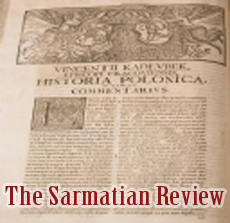| This Issue | Back Issues | Editorial Board | Contact Information |

Katyń
James E. Reid
A film directed and written by Andrzej Wajda. Based on the novel Post Mortem by Andrzej Mularczyk. In Polish, Russian, and German, with English subtitles. With archival black and white film footage. Running time: 2:01 hours.
for Samir Baijal
In a forest near Katyń and elsewhere (Mednoe and Kharkiv) in 1940, Poland’s Soviet “allies” murdered 21,857 Polish officers and bulldozed their bodies into a mass grave. Until the late 1980s the government of Soviet-occupied Poland claimed that the German army had carried out the massacre in 1943 when they controlled that area of Poland. Katyń, Andrzej Wajda’s latest film, opens with grey clouds drifting across the screen. They obscure and then part to reveal the title and the opening credits. For the next two hours the film pierces the fog of war and lies surrounding Katyń. Wajda was thirteen when his father was killed there. After making over four dozen films, he waited until he was eighty-two to make Katyń. One of his primary concerns was to examine how this massive lie contaminated Polish life for as long as it did.
Katyń opens early in the war with a scene on a long bridge. Polish refugees running from the Russian invasion from the east encounter Polish families escaping from the German army’s advance from the west. The disbelief and confusion of the men, women, and children prefigures the confusion of the half century of lies that descended on Poland after the war. A period so dark that throughout the film a number of characters declare with certainty, “There will never be a free Poland.” Overcast and cold hard light falls on the country in these decades, without a clear blue sky in sight.
The movie Katyń is less the story of the murders of the Polish officers than the story of how the lie of Katyń poisoned the lives and hopes of Polish citizens for decades. A lie this big produces many descendants.
Wajda assumes a familiarity with this period of Polish history as his film cuts across the years. As the truth of the Soviet occupation of Poland unfolds, more and more people are filled with disbelief at what is happening. After Poland comes under complete Soviet domination, the Russians spread the lie that the German army killed the officers at Katyń in 1943. It becomes a necessary lie for those who want to thrive under the Soviet occupation. The lie continues as Polish satraps raise their faces from the Russian bootstraps and become the new leaders of the country. During these transitions the viewer must be attentive to shifts in location and time, as Wajda follows the Katń lie that metastasizes rapidly throughout the body politic of Poland.
Katyń is often less the story of the murders of the Polish officers than the story of how the lie of Katyń poisoned the lives and hopes of Polish citizens for decades. A lie this big produces many descendants. Those who accept the lies receive the rewards of position, power, and the good life-all the perquisites of self-abasement.
Those who refuse face a varying but certain fate. After the Second World War, the student applicant who refuses to state on his CV that his father died in 1943 at Katyń is refused admission to college. During the war university professors who believe that logic, reason, and solidarity with the chancellor will prevail with the occupying German army are shipped immediately to a concentration camp. The Polish lieutenant who thought he could live with his small wartime betrayal during the years after the war ends kills himself after getting drunk and trying to bring the lie out in the open in a crowded bar, as he shouts, “It’s a lie. You all know it’s a lie,” and no one responds. The confusion and deception that twist this lieutenant’s heart are convincingly portrayed by Andrzej Chyra.
Wajda populates the screen with telling and sometimes fleeting details. A young woman leaves a theater to purchase a gravestone with the date of her father’s death in 1940 at Katyń. She refuses to accept the 1943 lie. As she exits the theater for her fate a performance notice appears briefly behind her, advertising that Sophocles’ Antigone will be mounted soon. For carrying out forbidden funeral rites for her brother, Antigone was condemned to be buried alive. This young woman is turned away from consecrated ground by the church, and then cast into an underground prison merely for having 1940 carved into her father’s gravestone. Before she is imprisoned, a friend questions her about the wisdom of this contemporary Antigone’s dangerous choice. She replies, “I choose the murdered, not the murderers.”
The convincing portrayals of grief and desperation in Katyń make it a difficult film to watch. It is, however, leavened by grim humor. An army chaplain is imprisoned with Polish officers early in the film. As he takes an officer’s confession, a Russian guard opens the door suddenly. Just as suddenly, the chaplain picks up a newspaper to shield the penitent, and begins to read it studiously. In another scene, a Russian captain is billeted with a family, one of whose members is a Polish officer. When Russian soldiers arrive to round up these family members, he conceals a mother and her little girl. At the last minute, he sees the girl’s teddy bear on the floor and hides it under his clothes.
Many of the actors appear to have waited their whole lives to present the truth. In the decades after the war, in what passes for peacetime, a character asks, “Why live with so much evil around?” Even though we live far from that terrible time, it is a question we must ask ourselves. Andrzej Wajda‘s testament of Katyń, late in life, replies to this question with a resounding affirmation.
Back to the April 2009 Issue
The Sarmatian Review
sarmatia@rice.edu
Last updated 5/1/09